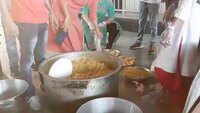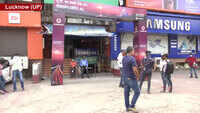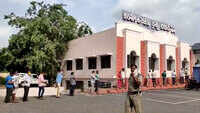
CHANDIGARH: Relying on a seminal textbook on medical jurisprudence for its research about charred bodies, the Punjab and Haryana high court has ordered release of two convicts, who were languishing in jail for around 16 years on charge of murdering a colleague and setting his body on fire in a Karnal village.
The case involved the February 2004 murder of a farm worker, Patti allegedly by his colleagues, Raju and Mohan, at a Rattak village farm in Haryana's Karnal district, which was owned by Manjoor Singh. The man had allegedly been strangled and then his body was burnt with paddy straw in the fields. On complaint of Manjoor Singh, the two accused were arrested and a few bones were recovered by the investigating officer from the burning straw. Karnal additional sessions judge on June 15, 2005 sentenced the two men to life imprisonment for murder.
Bones too fragmentary to give opinion: FSL
The bench observed that temperature seldom exceeds 1200 degree Celisus in an ordinary house fire. It is, therefore, unlikely that the body of an adult will burn so completely that it will leave no trace. If the body is not completely consumed, fragments of bones left would afford sufficient evidence to indicate whether they were human or not.
“The combustion of a body is rarely so complete as to reduce it to ashes. By sifting the ashes through sieves, fragments of bones can be collected and identified by a careful study. Incineration of an adult human body for the purpose of cremation requires 1½ hours at 1600-1800 degree Celsius, and the resultant ashes weigh about 4-6 kg,” the bench said-.Such human ash contains bone pieces which may still be identified. Even on the most badly charred body, fragments of clothing may be found protected in folds of skin or in the flexures of armpits and groins; or traces of jewellery may be found. In the present case, the weight of bones and ashes was found only 250 grams,” observed the high court division bench as it set aside Raju and Mohan’s conviction for the murder. It also appreciated the assistance rendered by advocate V K Sachdeva, who also was the legal aid counsel. Referring to one of the most authoritative textbooks on medical jurisprudence, Modi — A Textbook of Medical Jurisprudence and Toxicology, the division bench observed that in some instances, burnt bones and ashes are forwarded to the medical officer for inspection, if the police suspect some foul play after a body is partially or completely burnt. In the present case, the forensic science laboratory (FSL) suggested that no opinion could be given regarding sex and age as the bones were too fragmentary and insufficient.
If the deceased had been wearing clothes, the same could have been intact with the bones. In the present case, police did not recover any clothes. Even the bones of the deceased were not sent for DNA examination, the bench added.
The case involved the February 2004 murder of a farm worker, Patti allegedly by his colleagues, Raju and Mohan, at a Rattak village farm in Haryana's Karnal district, which was owned by Manjoor Singh. The man had allegedly been strangled and then his body was burnt with paddy straw in the fields. On complaint of Manjoor Singh, the two accused were arrested and a few bones were recovered by the investigating officer from the burning straw. Karnal additional sessions judge on June 15, 2005 sentenced the two men to life imprisonment for murder.
Bones too fragmentary to give opinion: FSL
The bench observed that temperature seldom exceeds 1200 degree Celisus in an ordinary house fire. It is, therefore, unlikely that the body of an adult will burn so completely that it will leave no trace. If the body is not completely consumed, fragments of bones left would afford sufficient evidence to indicate whether they were human or not.
“The combustion of a body is rarely so complete as to reduce it to ashes. By sifting the ashes through sieves, fragments of bones can be collected and identified by a careful study. Incineration of an adult human body for the purpose of cremation requires 1½ hours at 1600-1800 degree Celsius, and the resultant ashes weigh about 4-6 kg,” the bench said-.Such human ash contains bone pieces which may still be identified. Even on the most badly charred body, fragments of clothing may be found protected in folds of skin or in the flexures of armpits and groins; or traces of jewellery may be found. In the present case, the weight of bones and ashes was found only 250 grams,” observed the high court division bench as it set aside Raju and Mohan’s conviction for the murder. It also appreciated the assistance rendered by advocate V K Sachdeva, who also was the legal aid counsel. Referring to one of the most authoritative textbooks on medical jurisprudence, Modi — A Textbook of Medical Jurisprudence and Toxicology, the division bench observed that in some instances, burnt bones and ashes are forwarded to the medical officer for inspection, if the police suspect some foul play after a body is partially or completely burnt. In the present case, the forensic science laboratory (FSL) suggested that no opinion could be given regarding sex and age as the bones were too fragmentary and insufficient.
If the deceased had been wearing clothes, the same could have been intact with the bones. In the present case, police did not recover any clothes. Even the bones of the deceased were not sent for DNA examination, the bench added.
Quick Links
Kerala Coronavirus Helpline NumberHaryana Coronavirus Helpline NumberUP Coronavirus Helpline NumberBareilly NewsBhopal NewsCoronavirus in DelhiCoronavirus in HyderabadCoronavirus in IndiaCoronavirus symptomsCoronavirusRajasthan Coronavirus Helpline NumberAditya ThackerayShiv SenaFire in MumbaiAP Coronavirus Helpline NumberArvind KejriwalJammu Kashmir Coronavirus Helpline NumberSrinagar encounter
Get the app








